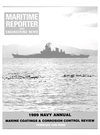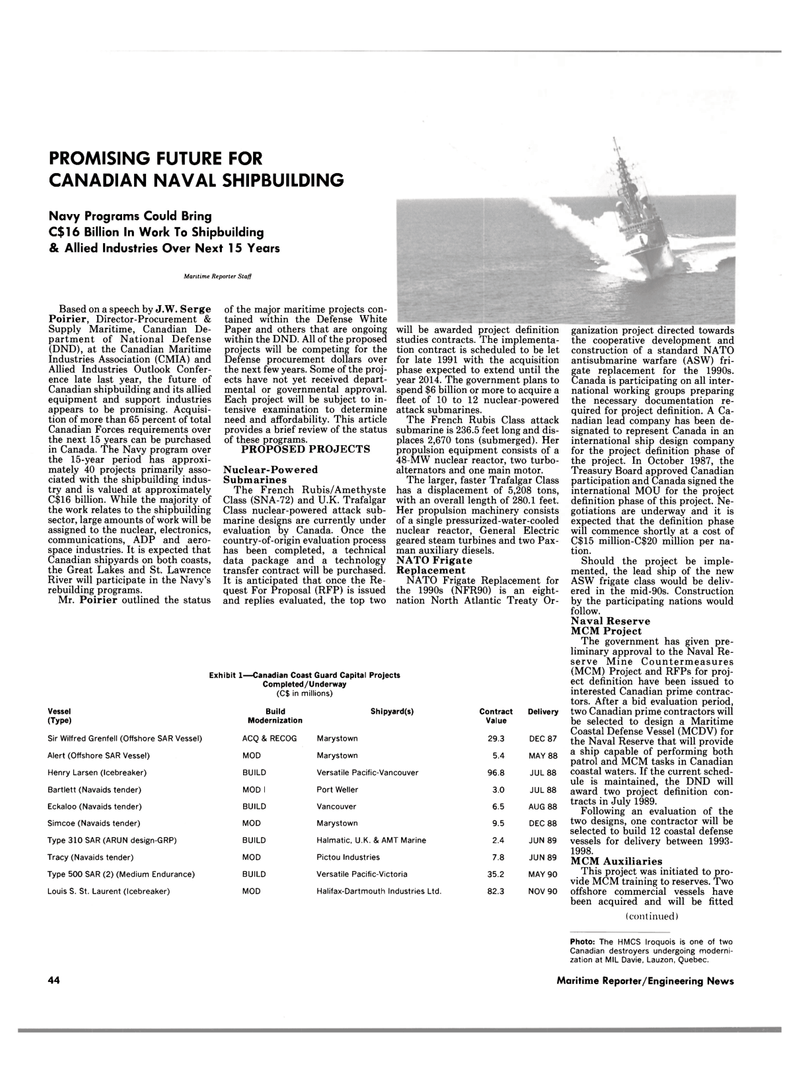
Page 42: of Maritime Reporter Magazine (February 1989)
Read this page in Pdf, Flash or Html5 edition of February 1989 Maritime Reporter Magazine
Maritime Reporter Staff
Navy Programs Could Bring
C$16 Billion In Work To Shipbuilding & Allied Industries Over Next 15 Years
PROMISING FUTURE FOR
CANADIAN NAVAL SHIPBUILDING
Based on a speech by J.W. Serge
Poirier, Director-Procurement &
Supply Maritime, Canadian De- partment of National Defense (DND), at the Canadian Maritime
Industries Association (CMIA) and
Allied Industries Outlook Confer- ence late last year, the future of
Canadian shipbuilding and its allied equipment and support industries appears to be promising. Acquisi- tion of more than 65 percent of total
Canadian Forces requirements over the next 15 years can be purchased in Canada. The Navy program over the 15-year period has approxi- mately 40 projects primarily asso- ciated with the shipbuilding indus- try and is valued at approximately
C$16 billion. While the majority of the work relates to the shipbuilding sector, large amounts of work will be assigned to the nuclear, electronics, communications, ADP and aero- space industries. It is expected that
Canadian shipyards on both coasts, the Great Lakes and St. Lawrence
River will participate in the Navy's rebuilding programs.
Mr. Poirier outlined the status of the major maritime projects con- tained within the Defense White
Paper and others that are ongoing within the DND. All of the proposed projects will be competing for the
Defense procurement dollars over the next few years. Some of the proj- ects have not yet received depart- mental or governmental approval.
Each project will be subject to in- tensive examination to determine need and affordability. This article provides a brief review of the status of these programs.
PROPOSED PROJECTS
Nuclear-Powered
Submarines
The French Rubis/Amethyste
Class (SNA-72) and U.K. Trafalgar
Class nuclear-powered attack sub- marine designs are currently under evaluation by Canada. Once the country-of-origin evaluation process has been completed, a technical data package and a technology transfer contract will be purchased.
It is anticipated that once the Re- quest For Proposal (RFP) is issued and replies evaluated, the top two will be awarded project definition studies contracts. The implementa- tion contract is scheduled to be let for late 1991 with the acquisition phase expected to extend until the year 2014. The government plans to spend $6 billion or more to acquire a fleet of 10 to 12 nuclear-powered attack submarines.
The French Rubis Class attack submarine is 236.5 feet long and dis- places 2,670 tons (submerged). Her propulsion equipment consists of a 48-MW nuclear reactor, two turbo- alternators and one main motor.
The larger, faster Trafalgar Class has a displacement of 5,208 tons, with an overall length of 280.1 feet.
Her propulsion machinery consists of a single pressurized-water-cooled nuclear reactor, General Electric geared steam turbines and two Pax- man auxiliary diesels.
NATO Frigate
Replacement
NATO Frigate Replacement for the 1990s (NFR90) is an eight- nation North Atlantic Treaty Or-
Exhibit 1—Canadian Coast Guard Capital Projects
Completed/Underway (C$ in millions)
Vessel Build Shipyard(s) Contract Delivery (Type) Modernization Value
Sir Wilfred Grenfell (Offshore SAR Vessel) ACQ & RECOG Marystown 29.3 DEC 87
Alert (Offshore SAR Vessel) MOD Marystown 5.4 MAY 88
Henry Larsen (Icebreaker) BUILD Versatile Pacific-Vancouver 96.8 JUL 88
Bartlett (Navaids tender) MOD 1 Port Weller 3.0 JUL 88
Eckaloo (Navaids tender) BUILD Vancouver 6.5 AUG 88
Simcoe (Navaids tender) MOD Marystown 9.5 DEC 88
Type 310 SAR (ARUN design-GRP) BUILD Halmatic, U.K. & AMT Marine 2.4 JUN 89
Tracy (Navaids tender) MOD Pictou Industries 7.8 JUN 89
Type 500 SAR (2) (Medium Endurance) BUILD Versatile Pacific-Victoria 35.2 MAY 90
Louis S. St. Laurent (Icebreaker) MOD Halifax-Dartmouth Industries Ltd. 82.3 NOV 90 ganization project directed towards the cooperative development and construction of a standard NATO antisubmarine warfare (ASW) fri- gate replacement for the 1990s.
Canada is participating on all inter- national working groups preparing the necessary documentation re- quired for project definition. A Ca- nadian lead company has been de- signated to represent Canada in an international ship design company for the project definition phase of the project. In October 1987, the
Treasury Board approved Canadian participation and Canada signed the international MOU for the project definition phase of this project. Ne- gotiations are underway and it is expected that the definition phase will commence shortly at a cost of
C$15 million-C$20 million per na- tion.
Should the project be imple- mented, the lead ship of the new
ASW frigate class would be deliv- ered in the mid-90s. Construction by the participating nations would follow.
Naval Reserve
MCM Project
The government has given pre- liminary approval to the Naval Re- serve Mine Countermeasures (MCM) Project and RFPs for proj- ect definition have been issued to interested Canadian prime contrac- tors. After a bid evaluation period, two Canadian prime contractors will be selected to design a Maritime
Coastal Defense Vessel (MCDV) for the Naval Reserve that will provide a ship capable of performing both patrol and MCM tasks in Canadian coastal waters. If the current sched- ule is maintained, the DND will award two project definition con- tracts in July 1989.
Following an evaluation of the two designs, one contractor will be selected to build 12 coastal defense vessels for delivery between 1993- 1998.
MCM Auxiliaries
This project was initiated to pro- vide MCM training to reserves. Two offshore commercial vessels have been acquired and will be fitted (continued)
Photo: The HMCS Iroquois is one of two
Canadian destroyers undergoing moderni- zation at MIL Davie, Lauzon, Quebec. 44 Maritime Reporter/Engineering News

 41
41

 43
43
